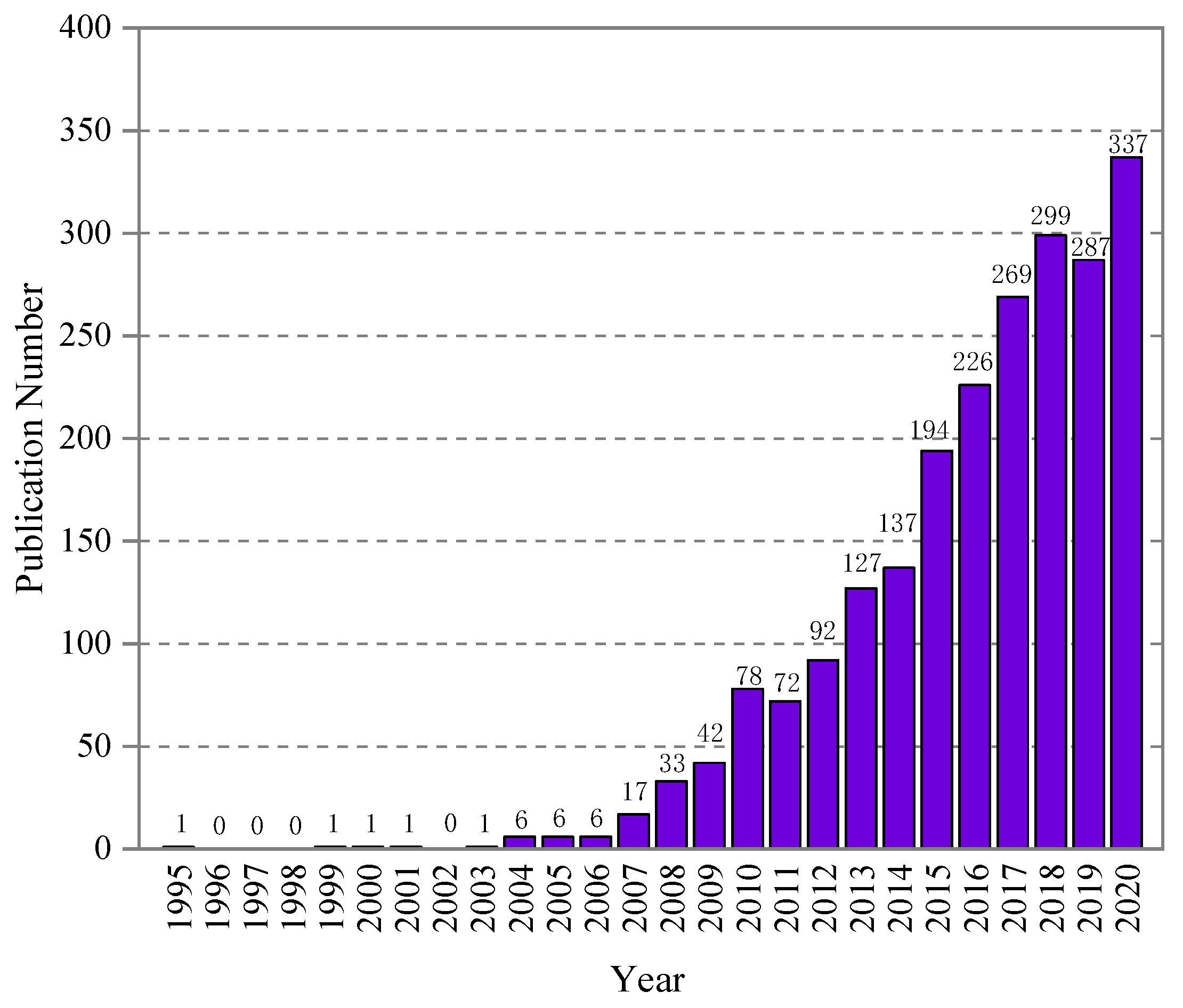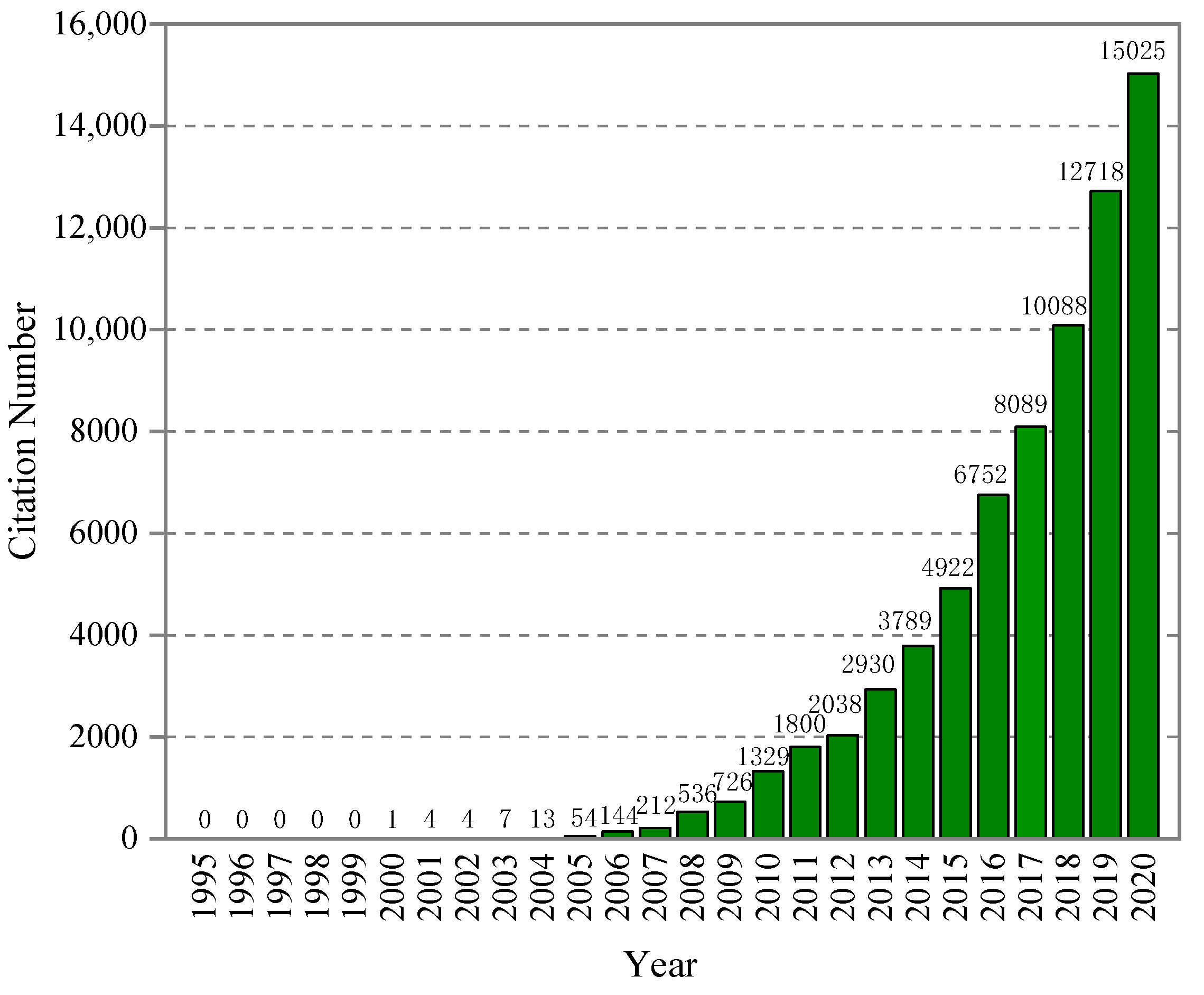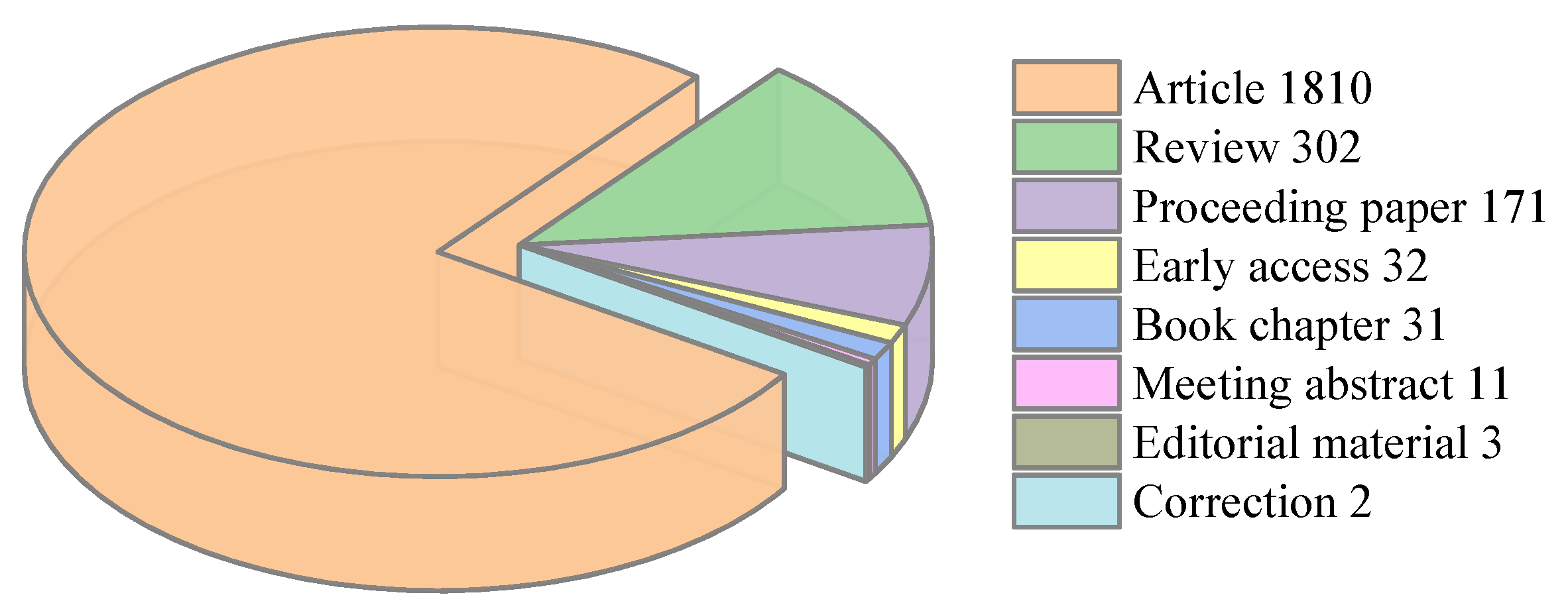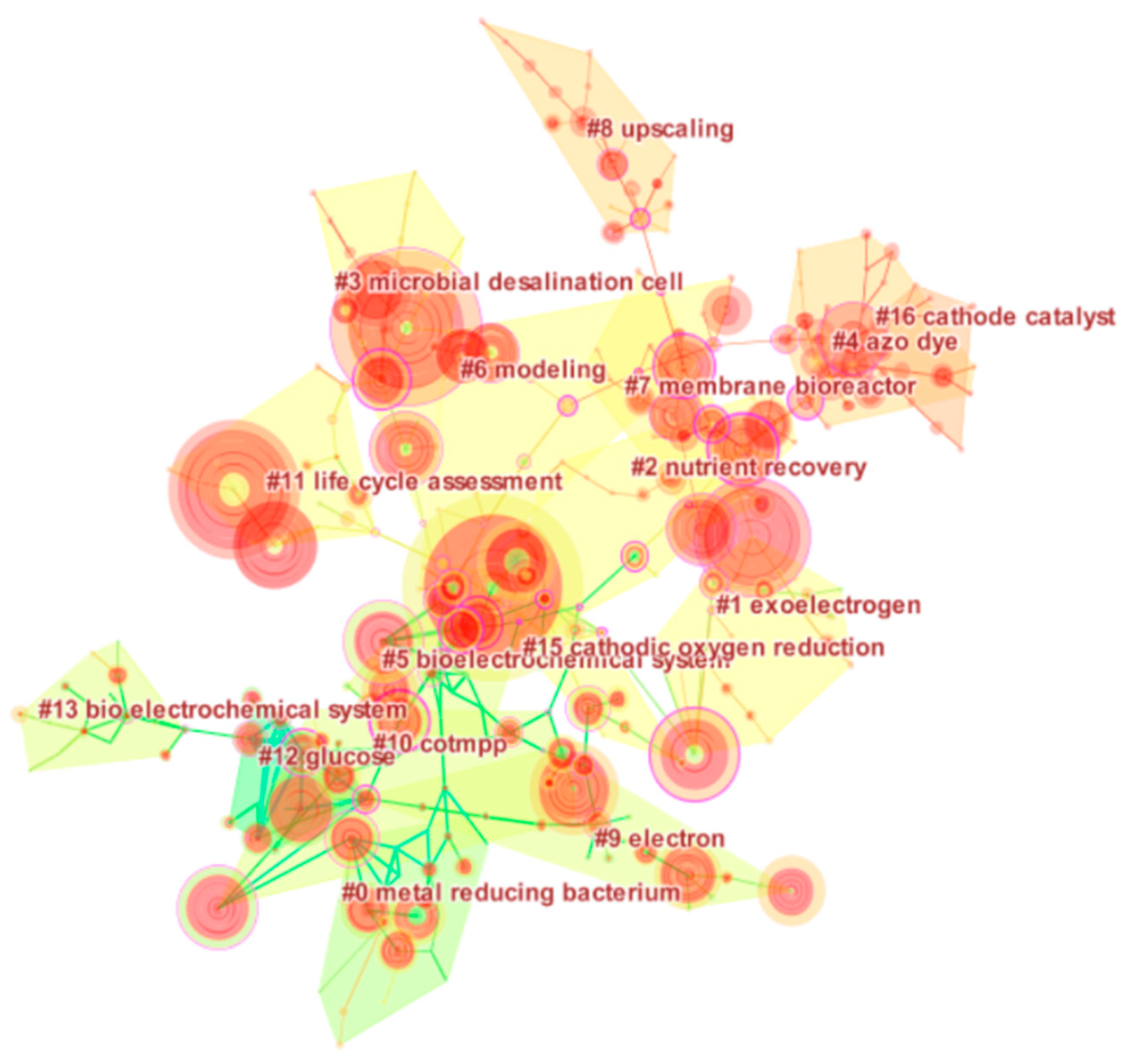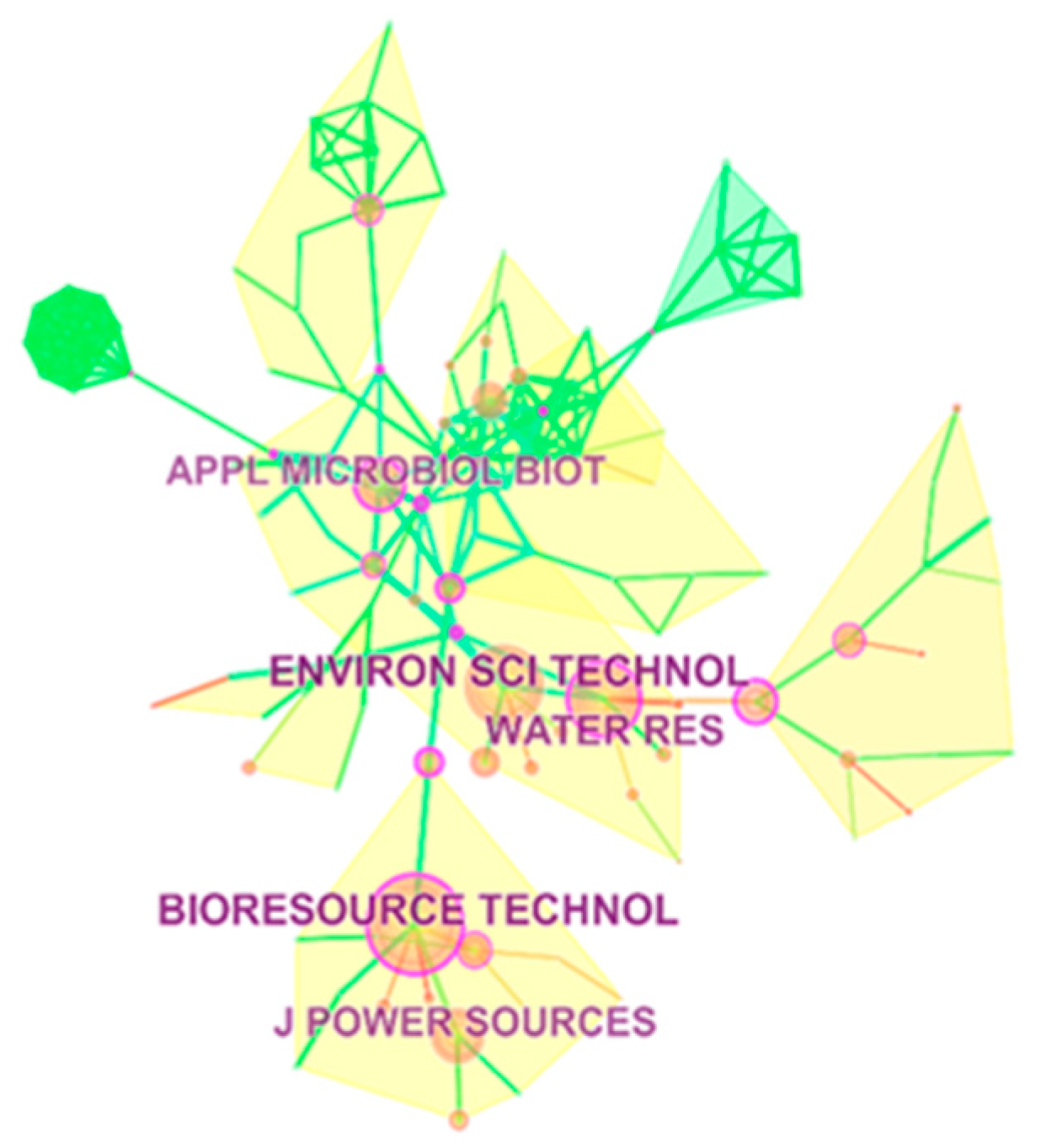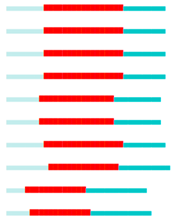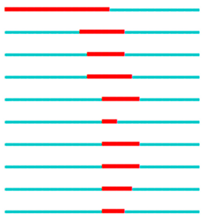1. Introduction
Nowadays, the two major global problems facing human beings are energy shortage and environmental pollution [
1]. Therefore, great efforts have long been exerted in a simultaneous response to both the energy consumption and water contamination [
2]. The wastewater containing pollutants must be treated before being discharged into the environment [
3,
4]. At present, wastewater treatment is commonly treated with a conventional aerobic activated sludge reactor, anaerobic digester, membrane filtration, ion exchange, adsorption, coagulation, electrolytic reduction and so on [
5]. Nevertheless, the high expenditure of energy and the running cost are the two major restraining factors for the current wastewater treatment technologies [
6]. In addition, the presence of a large amount of residual generation can lead to secondary pollution among these technologies, which can be deleterious for the environment and ineffective in catching the energy potential from wastewater [
7]. Therefore, it is essential to establish a wastewater treatment technology, which is required to be reliable, sustainable, and cost-effective [
8].
In recent years, microbial fuel cells (MFCs) have been demonstrated as a promising yet challenging technology that serves a dual purpose: pollutant removal and energy recovery [
4,
9]. In MFCs, the oxidation of organic compounds occur in an anode chamber catalyzed by microbes, while the electrons are transferred to a cathode in which reduction takes place, generating bioenergy and accomplishing water treatment simultaneously [
10,
11,
12]. In 2001, it was first proposed to establish the mode of using MFCs to achieve power generation and wastewater treatment, in which starch industrial wastewater was used as the substrate electricity generation [
13]. Since then, MFCs have been widely used to treat different types of industrial and domestic wastewater, such as that of molasses [
14], yogurt [
15], oil refineries [
16], beer breweries [
17], the chocolate industry [
18], the paper industry [
19] and so on.
Compared with other wastewater treatment technologies, MFCs have the following significant advantages: (1) direct conversion of substrates energy into electricity, (2) low activated sludge generation, (3) being robust and insensitive to environmental factors (e.g., temperature), (4) absence of gas treatment, (5) without any energy input for aeration, and (6) a widespread application in places lacking electrical infrastructures [
20,
21]. MFCs have proven to have great potential for industrial applications in several types of wastewater treatment [
22]. To date, the number of papers on MFCs in wastewater treatment is increasing. Carlos et al. [
6] demonstrated that MFCs can generate electricity and achieve wastewater treatment effectively. However, few works in the literature have focused on the development trend of MFC in wastewater treatment based on bibliometrics and visualization technology. Bibliometric is an effective and useful tool that can evaluate the scientific production and research trends in a specific research field [
23]. CiteSpace is an information visualization software developed by Chen Chaomei from Drexel University, which is primarily based on Java language for analysis and visualization of co-citation networks [
24,
25]. In recent years, the majority of scholars gradually increased attention on it. Li et al. [
26] estimated the research front of bioelectrochemical systems by CiteSpace software. Through quantitative and visual analysis of publication information collected from Web of Science, it can provide novel sight on the changing and development trend of MFCs research in wastewater treatment, which is of great significance for researchers to further understand the direction of MFCs for future study and application.
With the aim to explore the key literatures and major research area on MFCs in wastewater treatment, we summarized the published information in this field from the Web of Science Core Collection in the past 25 years (1995–2020) and conducted co-citation analysis to identify the core literatures and investigate the major research area on MFCs in wastewater treatment by CiteSpace. This study estimates the most important and remarkable research trends and hot spots of MFCs usage in wastewater treatment. In addition, this study provides an overview of the development of MFCs usage in wastewater treatment and also offers valuable suggestions to energy and environmental management.
3. Current Status of Microbial Fuel Cells (MFCs) in Wastewater Treatment
Based on the document set we retrieved, we concluded that the article related MFCs in wastewater treatment was first reported in 1995. In the last 25 years, the quantity of published documents on MFCs in wastewater treatment increased from 1 in 1995 to 337 in 2020. The number of publications has steadily increased every year. This fully explains the research on MFCs in wastewater treatment getting more and more attention. The distribution of annual citation is shown in
Figure 2. There is an obvious upward trend for the annual citation on MFCs in wastewater treatment.
As is shown in
Figure 3, a total of 2233 publications related to MFCs in wastewater treatment were categorized into 8 document types (Article, Review, Proceeding paper, Early access, Book chapter, Meeting abstract, Editorial material, and Correction). In addition, Articles are the dominant document publication type (comprising 81.0% of the overall documents), followed by Reviews (13.5%), Proceeding papers (7.6%) and other types of publications. Among these 2233 publications related to studies of MFCs in wastewater treatment, they were categorized into more than 50 subjects. The top 10 subject categories on MFCs in wastewater treatment are summarized and listed in
Table 1.
“Environmental Sciences” and “Energy Fuels” were identified as the two most popular subject categories with 652 publications and 639 publications, which contributed 29.198% and 28.616% of the total publications, respectively. “Biotechnology Applied Microbiology” contributed 25.078% of the total publications and occupied the third most popular subject category position, followed by “Engineering Environmental”, “Engineering Chemical”, “Electrochemistry”, “Agricultural Engineering”, “Water Resources”, “Chemistry Physical”, and “Chemistry Multi-disciplinary”.
Hundreds of journals have published research related to MFCs in wastewater treatment.
Table 2 shows the top 10 journals which produced the largest quantity of publications in the field of MFCs in wastewater treatment. We found that the journal
Bioresource Technology with 250 publications about MFCs in wastewater treatment published the greatest number of articles and accounts for 11.196% of the total publications. The second productive journal is
International Journal of Hydrogen Energy with 77 articles followed by
Chemical Engineering Journal,
Water Research,
Journal of Power Sources,
Water Science and Technology,
Environmental Science & Technology,
Science of the Total Environment,
Journal of Chemical Technology and Biotechnology and
Environmental Technology.
The research on MFCs in wastewater treatment in different countries/territories attracted different degrees of attention. The top 10 most prolific countries on MFCs in wastewater treatment are listed in
Table 3. From
Table 3, China was identified to publish the largest number of publications on MFCs in wastewater treatment, followed by the U.S.A., India, South Korea, Spain, Australia, Malaysia, England, Iran and Italy.
As is known to all, China and the U.S.A. are currently the world’s top two economies. In order to cope with the increase in global energy demand and the depletion of fossil fuels, scientists and researchers in the two countries have paid much attention to eco-friendly and economically feasible renewable energy sources. As a promising environmentally friendly technology, MFCs can directly convert organic energy into electrical energy, thereby achieving simultaneous power generation and waste recycling. Therefore, countries, led by China and the U.S.A., have conducted a lot of research on MFCs in wastewater treatment related research.
Table 4 indicates that Chinese Academy of Sciences from China is the most productive institution on MFCs in wastewater treatment (98 publications). Harbin Institute of Technology from China is the second most productive institutions with 92 publications followed by Pennsylvania State University (U.S.A.), Virginia Polytechnic Institute and State University (U.S.A.), Indian Institute of Technology (India), Tsinghua University (China), Dalian University of Technology (China), Nankai University (China), Indian Institute of Chemical Technology (India), and University of Science and Technology of China (China). Among the above 10 mentioned institutions, 6 belonged to China, with 2 from U.S.A. and anther 2 from India. Though South Korea, Spain, Australia, Malaysia, England, Iran and Italy were the most productive countries on MFCs in wastewater treatment, there are no institutions from these countries involved in the MFCs-related research.
6. Discussion
We conducted a scientific metrological review on MFCs in wastewater treatment by retrieving 2233 documents from Web of Sciences.
Environmental Sciences was identified as having the most popular subject categories on MFCs in wastewater treatment, followed by
Energy Fuels and
Biotechnology Applied Microbiology. The journal of
Bioresource Technology is the most productive journal, having published the highest number of documents related to MFCs in wastewater treatment. Peoples R China, U.S.A., India, South Korea, and Spain published the highest number of documents in this area. As the largest developing country, China is confronted with an energy shortage and environmental pollution. Experts and scholars from China are committed to study the recycling of wastewater. MFC is an environmental and eco-friendly technology that captures energy through the oxidation of organic substrates in wastewater and converts them into electric current with the help of microorganisms as catalysts [
49]. Chinese Academy of Sciences from China, Harbin Institute of Technology from China, Pennsylvania State University from U.S.A., Virginia Polytechnic Institute and State University from U.S.A., and Indian Institute of Technology from India are the five most productive institutions on MFCs in wastewater treatment. Logan BE from Pennsylvania State University is the world′s leading expert on MFCs in wastewater treatment.
“Metal reducing bacterium”, “Exoelectrogen”, “Nutrient recovery”, “Microbial desalination cell”, “Azo dye”, “Bioelectrochemical system”, “Modeling”, “Membrane bioreactor”, “Upscaling” and “Electron” were evaluated as the major research areas of MFCs in wastewater treatment. MFCs can be used to treat wastewater with heavy metals while generating electricity. In recent years, many studies have focused on metal reducing bacterium [
50,
51,
52]. Becerril-Varela et al. [
52] evaluated the feasibility of using an enrichment of iron-reducing bacteria coupled with acetate oxidation to generate electricity in MFC and identified the microorganisms in the MFC. Studies on MFCs in wastewater treatment have also focused on “Exoelectrogen”, “Nutrient recovery”, “Microbial desalination cell” and “Electron”. Li et al. [
53] discovered a novel exoelectrogen that can be used to produce electricity and degrade petroleum hydrocarbon. Li et al. [
54] demonstrated that the extracellular electron transfer process between electroactive biofilm and electrode is a key step for the performance of MFCs, which is closely related to the enrichment of exoelectrogens and the electrocatalytic activity of the electrode. Recently, MFCs were studied to recover nutrients from wastewater and generate electricity simultaneously [
55,
56,
57]. Microbial desalination cell has attracted extensive attention in recent years [
58,
59,
60,
61,
62]. Microbial desalination cell is a low-cost and sustainable option for simultaneously treating wastewater, desalinating saline water, generating electricity, and recovering nutrients from wastewater [
63]. Microbial desalination cell can be used to decrease the organic load/COD in wastewater [
64]. There are two important mechanisms of extracellular electron transfer, namely direct electron transfer and mediated electron transfer [
65]. The exoelectrogens in MFCs utilize metabolism and extracellular electron transfer pathways to obtain energy and generate electricity from organic matter in wastewater [
66]. Moreover, “Microbial Fuel Cells: Methodology and Technology” published by Logan, et al. on
Environmental Science & Technology was selected as the most cited article.
Environmental Science & Technology, Bioresource Technology and
Water Research are the most representative journals of MFCs in wastewater treatment.
Furthermore, “Azo dye”, “Membrane bioreactor” and “up scaling” were regarded as new emerging research trends on MFCs in wastewater treatment. Azo dyes are one of the most consumed dyes in the world and are used as colorants in food, textile, and pharmaceutical industries [
67,
68]. It is very urgent to develop efficient, environmentally friendly, and cost-effective technologies for azo dye removal due to the increasingly strict requirements of environmental regulations [
69]. In recent years, many studies on azo dye have largely focused on electrode material, operational parameters and reactor configuration [
70,
71,
72]. MFC integrated with constructed wetland was developed for the treatment of azo dye wastewater [
73,
74,
75]. Moreover, an MFC-biofilm electrode reactor coupled system was established to promote the degradation of azo dye [
76]. Li et al. [
77] developed an MFC–microbial electrolysis cell coupled system to promote the decolorization of azo dye and evaluated the effects of anodic substrate concentration and cathodic pH on reactor performance. Li et al. [
78] reported that the addition of anthraquinone extracted from natural plants to MFCs can enhance the detoxification and decolorization of azo dyes by mediating electron transfer. An integrated system combining a membrane bioreactor with a MFC was recently developed to augment wastewater treatment [
79,
80,
81]. More and more studies have focused on MFCs scale-up [
82,
83]. A scalable composite-engineered electrode module was created for large-scale application and can be used to enhance the decolorization of azo dye wastewater [
84,
85]. The large-scale application of MFCs has shown good performance in the field of wastewater treatment [
86].
